Infrastructure
Shimla Development Roadmap: How The Himachal Government Plans To Transform The 'Queen Of Hills'
V Bhagya Subhashini
Jun 20, 2023, 06:02 PM | Updated 06:01 PM IST
Save & read from anywhere!
Bookmark stories for easy access on any device or the Swarajya app.
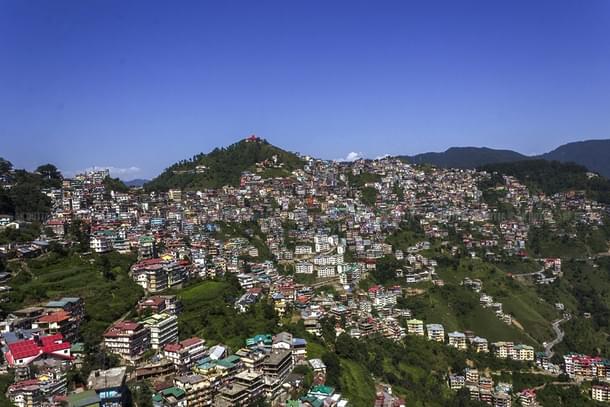
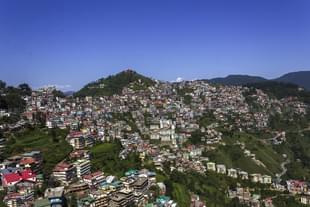
The Himachal Pradesh cabinet on Monday (19 June) approved the final draft of the Shimla Development Plan (SDP), which includes new provisions with regard to the number of floors, habitable attic and garage in a building.
The cabinet, in a meeting presided by Chief Minister Sukhvinder Singh Sukhu, cleared the draft plan presented by the Urban Development Department.
Industries Minister Harsvardhan Chauhan stated that one floor plus an attic would be allowed in green areas, while two floors and an attic would be permitted in core areas. He added that there are different parameters for various areas.
The National Green Tribunal (NGT) must approve the implementation of the plan, as it has prohibited construction in green and core areas.
The cabinet made a decision to establish a four-lane planning area and bring up to 100 metre from the edge of the road, under its jurisdiction, to regulate the unplanned, unregulated, and rampant unauthorised constructions along the Parwanoo-Shimla, Shimla-Matour, Pathankot-Mandi, and Kiratpur-Manali national highways.
The Himachal Pradesh government proposed a development plan for Shimla in April 2022. However, a month later, the NGT halted the plan, citing potential environmental and public safety effects.
In 2015, the tribunal formed an expert group to investigate the impact of existing structures on Shimla's environment and ecology, sewage system, and water supply.
According to the committee's report from 2017, Shimla has well exceeded its carrying capacity in terms of disaster risk management.
It stated that decades of unmanaged and hazardous construction had resulted in an exceptionally susceptible built environment, leading to enormous loss of life in natural disasters such as earthquakes and landslides.
The committee discovered that the majority of the buildings are built on slopes greater than 70 degree, which necessitates extensive contour cutting, making the ground prone to landslides.
It had asked for the identification of all buildings that had been built without regard for seismic sensitivity or load-bearing capacity, as well as their demolition, relocation, and reconstruction within 5-10 years.
Need For Sustainable Urban Development In Shimla
Shimla, prior to its development as a hill station was described as an “obscure village”. The village was named ‘Shimla’ after the temple of Goddess Shyamala located in the village.
Known as the 'Queen of Hill Stations', Shimla has become a multifunctional city along with the dominance of tourism, administrative and institutional activities.
As a result of the increased urbanisation in and around hill cities, Shimla is currently experiencing issues with traffic, water scarcity, landslides, pollution of lakes and streams, damage to scenic attractiveness, and visual blight.
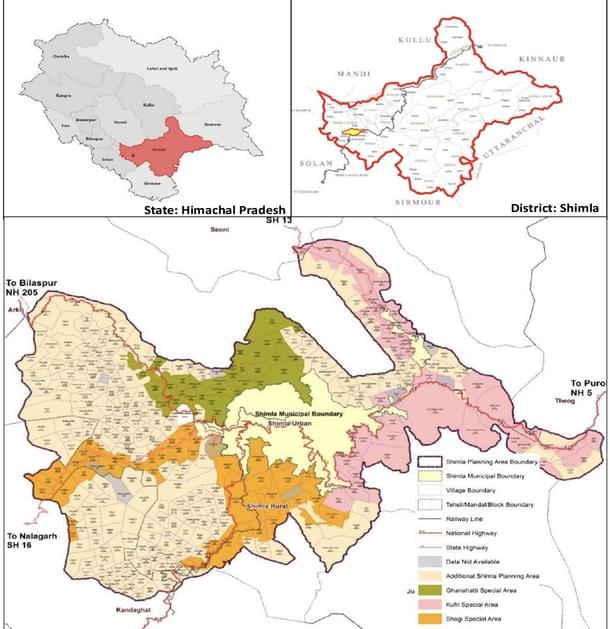
Ecological Concerns
For the past few decades, the importance of Shimla’s historical development, in terms of meticulous planning in accordance with environmental and ecological imperatives, and harmony of natural and built heritage has lost its sheen.
The city has witnessed the unprecedented impact of urban ills, especially haphazard construction activity and congestion of its prime tourist locations.
Shimla is also witnessing a spurt in construction activities, during the last few decades.
As per experts, about 90 per cent of the core city area has been built on slopes more than 60 degrees, thus making these constructions against architectural and geological norms. These factors make Shimla highly susceptible to natural disasters.
The area is also located in severe earthquake zones IV and V.
Seasonal landslides and uprooting of trees sometimes lead to deaths, extensive loss of property, and loss of livelihood ruining roads and infrastructure.
Population Pressure
The unplanned and indiscriminate development in the core, non-core, green and rural areas in Shimla Planning Area has given rise to serious environmental and ecological concerns.
Shimla was originally planned for a population of 25,000 people, while it accommodates more than 2,40,000 people besides the floating population of tourists.
In the past 120 years, the population has increased more than 15 times.
Urban Sprawl
The city is spread over seven hill spurs, namely, Jakhoo Hill, Elysium Hill, Museum Hill, Prospect Hill, Observatory Hill, Summer Hill and Potters Hill. These spurs are interconnected by roads.
Thus, the development pattern in Shimla is governed by topographical constraints such as steep slopes, elongated hilly spurs, forest areas and zones of perpetual sunshades.
Shimla is growing beyond its seams by leaps and bounds. Ribbon development along the highways and even along the minor roads emanating from the city is a common feature. A vast cityscape is in the formation.
Whereas the already existing areas have got congested, the fringes and peri-urban areas, especially the prominent ridges like Sanjauli, Cemetery, Dhalli, Bhattakufar, Mehli, Kangnadhar, Khalini, Bharari etc. are acquiring considerable proportions of development.
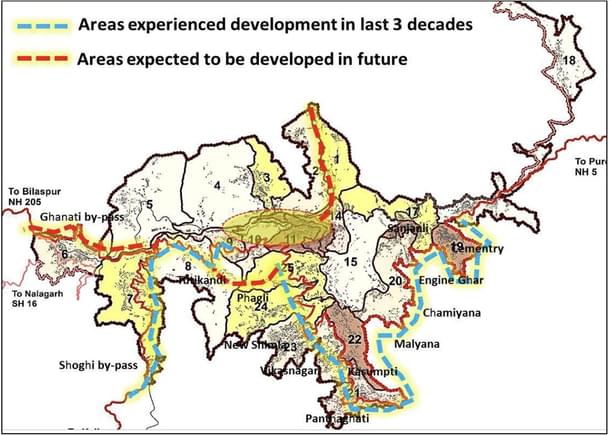

Irregular Building Plans In Shimla
Many buildings in Shimla have an irregular plan, that is, L shape, U shape etc. Buildings with regular plan (rectangular or square) perform better during earthquake.
If irregular shape like L, H, U or + are designed, construction joints should be provided at the junction of two different wings to avoid re-entrant corners. If a construction joint is not provided, buildings have the tendency to separate out from these corners.
The dimension of the offset and the proportion of the derived wings will determine the vulnerability of a building.
Rise In Slum pockets In Shimla
There are 53 slum pockets identified in the Shimla Municipal Corporation area (source: SMC), in which, there are 1,972 households/structures housing a population of 11,874, which is around 4 per cent of the total population in the city.
Unsustainable Tourism In Shimla
Present trends in tourism in Shimla are oriented towards increasing tourist volume. As a result, it threatens the capacity of tourist attractions because of overcrowding, congestion, traffic snarls and environmental pollution.
Aggressive tourism activities without proper planning, effective policy and institutional framework have created serious environmental problems in the mountain city.
Draft Development Plan (DP)
Shimla is still being developed in accordance with the 1979 Interim Development Plan (IDP).
The SDP has been prepared under Atal Mission for Rejuvenation and Urban Transformation (AMRUT) Scheme.
GIS-based development plan for Shimla Planning Area comprises of Shimla Municipal Corporation and its surrounding areas including Kufri, Shoghi and Ghanahatti Special Areas and additional villages.
The development plan is a set of strategic guidelines to validate systematic planned development in Shimla, which is sustainable, eco-friendly and conducive to economic growth.
The DP attempts to meet the emerging challenges of urban infrastructure and focuses on efficient land-use planning, environmental conservation, regeneration, and improving the quality of life by creating resilient and efficient infrastructural systems with the sufficient provision of amenities and other community services while upholding the social, community and cultural considerations.
Counter Magnet Towns
The vision of the DP Shimla envisages the development of a new counter magnet town in the peripheral area near the Airport (Jubarhatti) and Jathiya devi.
This counter magnet town will serve the purpose of commercial as well as residential needs of the increasing population.
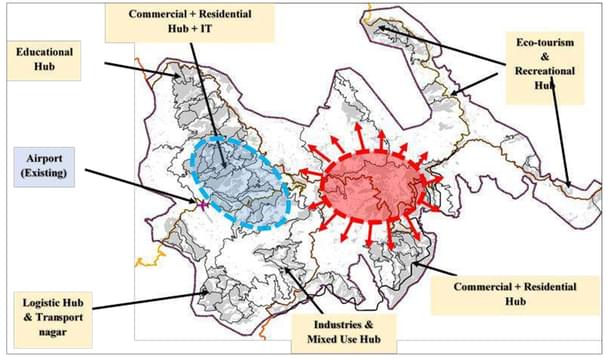
Satellite Townships
Apart from one major counter magnet town, satellite townships at Ghandal, Fagu, Naldehra and Chamiyana Area near four-lane by-pass road can be envisioned in line with the development trends as well as to decongest the core area.
Developing activity-based satellite towns will reduce the dependency of the residents of these areas and adjoining areas on Shimla for basic urban amenities such as education, health, trade and commerce.
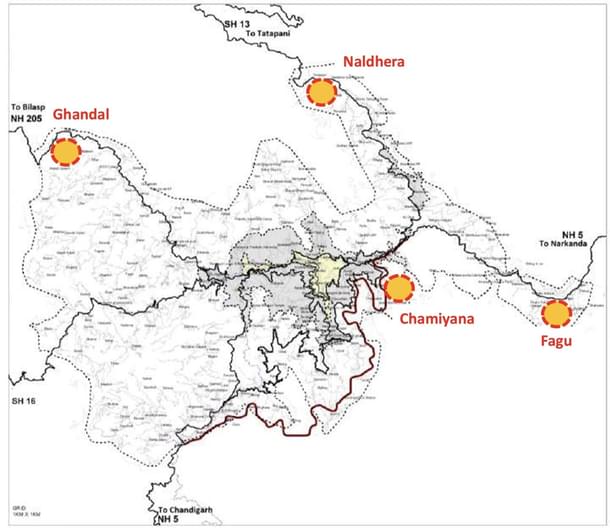
Way Forward
No Development Zones (NDZ): Identifying the areas strictly not to be disturbed and no other uses to be allowed in these zones except those permitted under the relevant legislation.
Slope of land: Areas with very steep slopes are not suitable for development, while areas with low slopes are highly suitable for development. As per NGT directives, land with a slope greater than 45 degree cannot be considered suitable for development.
Protection of forests and vegetation: 44 per cent of the total planning area is covered by forests and 22 per cent is used for agriculture. Thus, in order to maintain the ecological balance, the land area under forests shall be reserved and protected.
Preservation of natural hydrological bodies: Identifying the water bodies and limiting development in the immediate vicinity in the areas surrounding these water bodies, since the conservation of water bodies is very much important to maintain the environmental stability within the Shimla Planning Area.
Heritage conservation: Restoration, preservation and conservation of built heritage of Shimla is essential to maintain the unique aura of this hill station.
Development of more walkable streets: Planning and designing for walking is crucial for promoting a healthy public life, creating sustainable neighborhoods, enhancing social life and economy.
Promoting sustainable tourism: The eco-tourism development approach based on natural preservation imperatives, recognised to be most suited for Shimla also call for utmost care in preservation of traditional green cover on one hand and plantation of evergreen long lasting trees, on the other.
In conclusion, by recognising the intricate interface between tourism, heritage, and the environment, Shimla can forge a path towards a resilient and prosperous future, maintaining its status as a treasured hill station for generations to come.
V Bhagya Subhashini is a staff writer at Swarajya. She tracks infrastructure developments.





